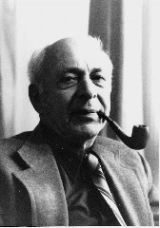





After graduation, Rotter attended the University of Iowa, where he took classes with Kurt Lewin. Rotter minored in speech pathology and studied with the semanticist Wendell Johnson, whose ideas had an enduring influence on Rotter's thinking about the use and misuse of language in psychological science. Upon finishing his master's degree, Rotter took an internship in clinical psychology -- one of the few available at the time -- at Worcester State Hospital in Massachusetts. In 1939, Rotter started his Ph.D. work at Indiana University, one of the few programs to offer a doctorate in clinical psychology. There, he completed his dissertation on level of aspiration and graduated in 1941. By earning his Ph.D. in clinical psychology after having done a predoctoral internship, Rotter became one of the very first clinical psychologists trained in what is now the traditional mode.
After service in the Army and Air Force during World War II, Rotter took an academic position at Ohio State University. It was here that he embarked on his major accomplishment, social learning theory, which integrated learning theory with personality theory. He published Social Learning and Clinical Psychology in 1954. Rotter also held strong beliefs about how clinical psychologists should be educated. He was an active participant in the 1949 Boulder Conference, which defined the training model for doctoral level clinical psychologists. He spoke persuasively that psychologists must be trained in psychology departments, not under the supervision of psychiatrists. His ideas are still influential today (Herbert, 2002).
In 1963, Rotter left Ohio State to become the director of the clinical psychology training program at the University of Connecticut. After his retirement, he remained professor emeritus there.
Rotter served as president of the American Psychological Association's divisions of Social and Personality Psychology and Clinical Psychology. In 1989, he was given the American Psychological Association's Distinguished Scientific Contribution award.
Rotter was married to Clara Barnes, whom he had met at Worcester State, from 1941 until her death in 1985. They had two children. He later married psychologist Dorothy Hochreich. Rotter died January 6, 2014, at the age of 97 at his home in Connecticut.
[The above information is based on a biographical essay written by Julian Rotter: Rotter, J. B. (1993). Expectancies. In C. E. Walker (Ed.), The history of clinical psychology in autobiography (vol. II) (pp. 273-284). Pacific Grove, CA: Brooks/Cole. Photos courtesy of University of Connecticut.]
The main idea in Julian Rotter's social learning theory is that personality represents an interaction of the individual with his or her environment. One cannot speak of a personality, internal to the individual, that is independent of the environment. Neither can one focus on behavior as being an automatic response to an objective set of environmental stimuli. Rather, to understand behavior, one must take both the individual (i.e., his or her life history of learning and experiences) and the environment (i.e., those stimuli that the person is aware of and responding to) into account. Rotter describes personality as a relatively stable set of potentials for responding to situations in a particular way.
Rotter sees personality, and therefore behavior, as always changeable. Change the way the person thinks, or change the environment the person is responding to, and behavior will change. He does not believe there is a critical period after which personality is set. But, the more life experience one has building up certain sets of beliefs, the more effort and intervention required for change to occur. Rotter conceives of people in an optimistic way. He sees them as being drawn forward by their goals, seeking to maximize their reinforcement, rather than just avoiding punishment.
Rotter has four main components to his social learning theory model predicting behavior. These are behavior potential, expectancy, reinforcement value, and the psychological situation.
Behavior Potential. Behavior potential is the likelihood of engaging in a particular behavior in a specific situation. In other words, what is the probability that the person will exhibit a particular behavior in a situation? In any given situation, there are multiple behaviors one can engage in. For each possible behavior, there is a behavior potential. The individual will exhibit whichever behavior has the highest potential.
Expectancy. Expectancy is the subjective probability that a given behavior will lead to a particular outcome, or reinforcer. How likely is it that the behavior will lead to the outcome? Having high or strong expectancies means the individual is confident the behavior will result in the outcome. Having low expectancies means the individual believes it is unlikely that his or her behavior will result in reinforcement. If the outcomes are equally desirable, we will engage in the behavior that has the greatest likelihood of paying off (i.e., has the highest expectancy). To have a high expectancy, people must believe both (a) that they have the capacity to enact the behavior effectively and (b) that that behavior will result in reinforcement.
Expectancies are formed based on past experience. The more often a behavior has led to reinforcement in the past, the stronger the person's expectancy that the behavior will achieve that outcome now. In addition, people do not need to have direct experience with reinforcement of a particular behavior. Rotter wrote that our observations of the outcomes of others' behaviors affect our own expectancies. If we see someone else being punished for a particular behavior, we don't have to experience punishment personally to form an expectancy that this behavior is likely to be punished.
It is important to note that expectancy is a subjective probability, because one common source of pathology is irrational expectancies. There may be no relationship whatsoever between the person's subjective assessment of how likely a reinforcement will be and the actual, objective probability of the reinforcer's occurring. People can either over- or underestimate this likelihood, and both distortions can potentially be problematic.
Reinforcement Value. Reinforcement is another name for the outcomes of our behavior. Reinforcement value refers to the desirability of these outcomes. Things we want to happen, that we are attracted to, have a high reinforcement value. Things we don't want to happen, that we wish to avoid, have a low reinforcement value. If the likelihood of achieving reinforcement is the same (i.e., expectancies are equal), we will exhibit the behavior with the greatest reinforcement value, the one directed toward the outcome we prefer most. As the name social learning theory suggests, the social environment is of primary importance in shaping our behavior. Social outcomes, such as approval, love or rejection, are powerful influences on our behavior. For people, the most important reinforcers are often social reinforcers.
As with expectancy, reinforcement value is subjective, meaning that the same event or experience can vastly differ in desirability, depending on the individual's life experience. Punishment from a parent would be negatively reinforcing to most children and something to be avoided. However, children who get little positive attention from parents can seek out parental punishment because it has a higher reinforcement value than neglect.
The value of any given reinforcer is determined in part by other, future reinforcers it might lead to. For example, doing well on an exam in a particular class would have a heightened reinforcement value, if you believe that doing well in that class will lead to being able to work in your professor's lab. Therefore, even an apparently trivial event can have a very strong reinforcement value, either positive or negative, if the individual sees it as leading to other strongly valued reinforcers.
The least amount of reinforcement that still has a positive value is known as the minimal goal. If people achieve an outcome that equals or exceeds their minimal goal, they will feel that they have succeeded. When the level of reinforcement falls below an individual's minimal goal, that reinforcement feels like failure. People differ in their minimal goals. Thus, the same outcome may represent success to one person (with a lower minimal goal) while it feels like failure to another person (with a higher minimal goal).
Predictive Formula. Behavior Potential (BP), Expectancy (E) and Reinforcement Value (RV) can be combined into a predictive formula for behavior:
This formula can be read as follows: behavior potential is a function of expectancy and reinforcement value. Or, in other words, the likelihood of a person's exhibiting a particular behavior is a function of the probability that that behavior will lead to a given outcome and the desirability of that outcome. If expectancy and reinforcement value are both high, then behavior potential will be high. If either expectancy or reinforcement value is low, then behavior potential will be lower.
Psychological Situation. The psychological situation represents Rotter's idea that each individual's experience of the environment is unique. Although the psychological situation does not figure directly into Rotter's formula for predicting behavior, Rotter believes it is always important to keep in mind that different people interpret the same situation differently. Different people will have different expectancies and reinforcement values in the same situation. Thus, it is people's subjective interpretation of the environment, rather than an objective array of stimuli, that is meaningful to them and that determines how they behave.
Generality versus Specificity. An important dimension of personality theories is the generality versus specificity of their constructs. General constructs are broad and abstract, while specific constructs are narrow and concrete. Both types of constructs have their advantages. A theory with general constructs allows one to make many predictions, across situations, from knowing only a small amount of information. The disadvantages of general constructs, though, are that they are harder to measure and the predictions made from them have a lower level of accuracy. Specific constructs, on the other hand, are easier to measure, and they can be used to make more accurate predictions. However, these predictions are limited to being situation-specific.
For example, knowing that someone is a generally hostile person allows us to make predictions that this individual will be hostile toward a range of people. Across situations, this person is likely to be more hostile to others than is someone low in hostility. However, our ability predict how hostile this person would be to Jane, for example, is limited, because there may be other factors that determine whether this individual will treat Jane in a hostile way during a particular encounter (e.g., person likes Jane, or situational factors inhibit an expression of hostility). On the other hand, if we know that this person hates Jane, we can predict with a high level of accuracy that this person will be hostile toward Jane. But, we will not be able to predict whether this person will treat other people in a hostile way.
A strength of Rotter's social learning theory is that it explicitly blends specific and general constructs, offering the benefits of each. In social learning theory, all general constructs have a specific counterpart. For every situationally specific expectancy there is a cross-situational generalized expectancy. Social learning theory blends generality and specificity to enable psychologists to measure variables and to make a large number of accurate predictions from these variables.
"Locus of Control." For many people, their only exposure to the ideas of Julian B. Rotter is his concept of generalized expectancies for control of reinforcement, more commonly known as locus of control. Locus of control refers to people's very general, cross-situational beliefs about what determines whether or not they get reinforced in life. People can be classified along a continuum from very internal to very external.
People with a strong internal locus of control believe that the responsibility for whether or not they get reinforced ultimately lies with themselves. Internals believe that success or failure is due to their own efforts. In contrast, externals believe that the reinforcers in life are controlled by luck, chance, or powerful others. Therefore, they see little impact of their own efforts on the amount of reinforcement they receive.
Rotter has written extensively on problems with people's interpretations of the locus of control concept. First, he has warned people that locus of control is not a typology. It represents a continuum, not an either/or proposition. Second, because locus of control is a generalized expectancy it will predict people's behavior across situations. However, there may be some specific situations in which people who, for example, are generally external behave like internals. That is because their learning history has shown them that they have control over the reinforcement they receive in certain situations, although overall they perceive little control over what happens to them. Again, one can see the importance of conceiving of personality as the interaction of the person and the environment.
Psychopathology and Treatment. Rotter is very opposed to the medical model conception of mental disorders as being diseases or illnesses. Rather, he conceives of psychological problems as maladaptive behavior brought about by faulty or inadequate learning experiences. Rotter (1969) wrote that pathology might develop when a "person anticipating punishment or failure may avoid situations physically, avoid by repression or may attempt to reach [his or her] goals through rationalization, fantasy or symbolic means" (p. 7).
For Rotter, the symptoms of pathology, like all behavior, are learned. Therefore, treatment should be considered a learning situation in which adaptive behaviors and cognitions are taught. The therapist-client relationship is viewed as being similar to a teacher-student relationship. Having a warm relationship between client and therapist gives the therapist more reinforcement value for the client. This allows the therapist to influence the client's behavior more through praise and encouragement. Much of current cognitive-behavioral treatment has its roots in Rotter's social learning theory, although these debts often go unacknowledged.
According to Rotter, pathology can develop due to difficulties at any point in his predictive formula. Behavior can be maladaptive, because the individual never learned more healthy behaviors. In this case, the therapist would make direct suggestions about new behaviors to try and would use techniques such as role-playing to develop more effective coping skills.
Expectancies can lead to pathology when they are irrationally low. If people have low expectancies, they do not believe their behaviors will be reinforced. Consequently, they put little effort into their behaviors. If they don't try to succeed, they are likely to fail. And, when they fail, it confirms their low expectancies. This process of decreasing expectancies is a common occurrence in pathology known as a vicious cycle. When clients have low expectancies, therapists attempt to increase clients' confidence by using their therapeutic influence to help clients (a) gain insight into the irrationality of their expectancies and (b) attempt behaviors they have been avoiding out of fear of failure. In general, social learning therapists always attempt to raise their clients' expectancies for reinforcement.
Lastly, reinforcement value problems can lead to pathology. Reinforcers are the goals we seek in life. If people set unrealistically high and unobtainable goals for themselves (i.e., have too high minimal goals), they are likely to experience frequent failure. This failure can lead to the development of the vicious cycle described above. In this situation, therapists would help clients to lower their minimal goals, developing reasonable, achievable standards for themselves. Flexibility in setting minimal goals is one sign of good mental health. It is better to strive, step by step, to achieve a series of goals than it is to set one distant, lofty goal for oneself. A Rotter therapist also wants clients to consider the long-term consequences of behavior, rather than just short-term consequences.
Haggbloom, S. J. et al. (2002). The 100 most eminent psychologists of the 20th century. Review of General Psychology, 6, 139-152.
Julian Rotter was also profiled in 2012 in UConn Today.




